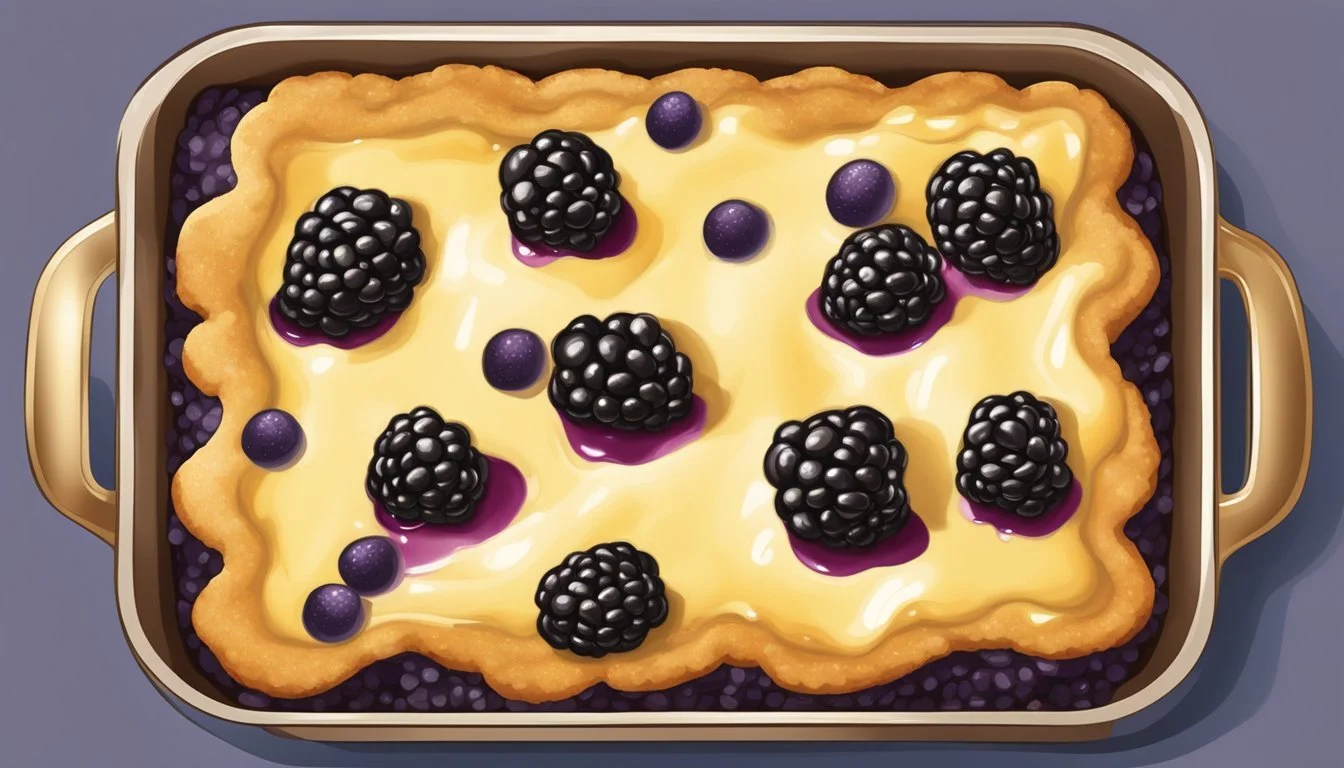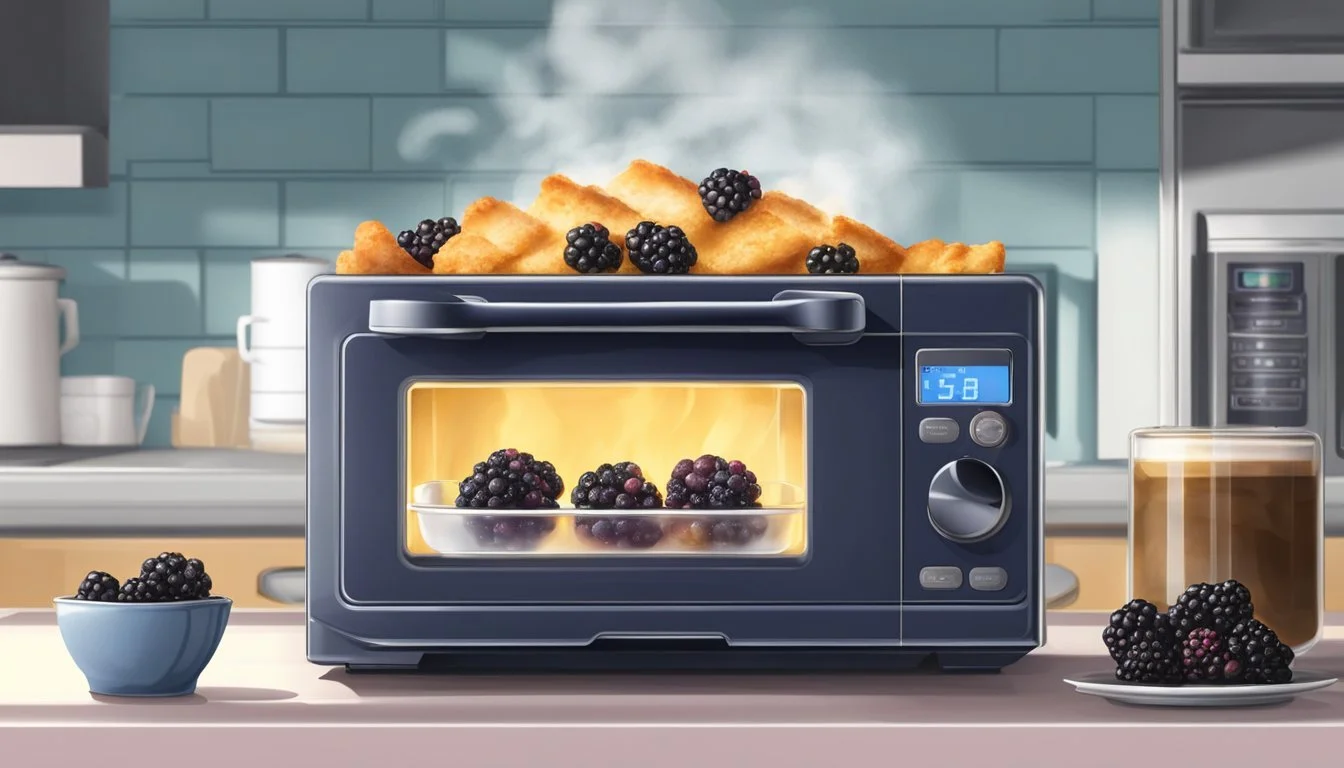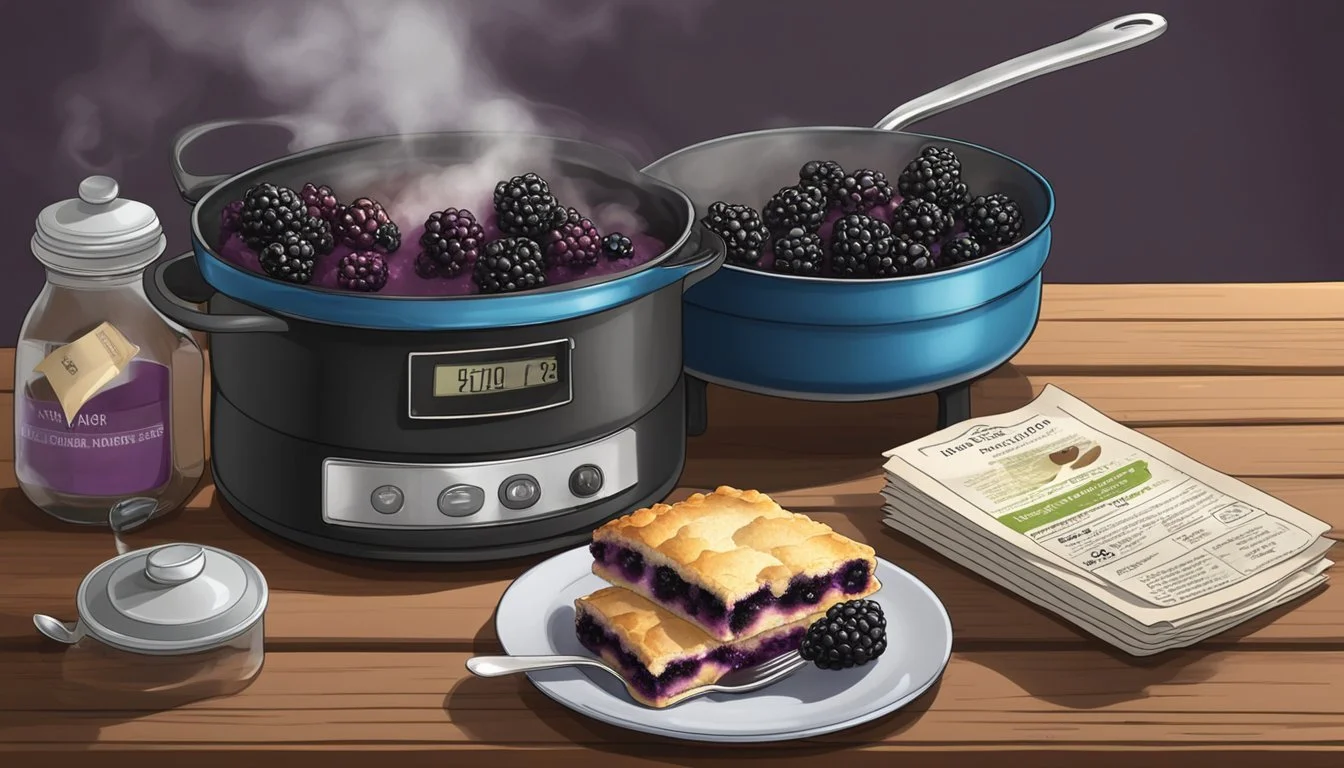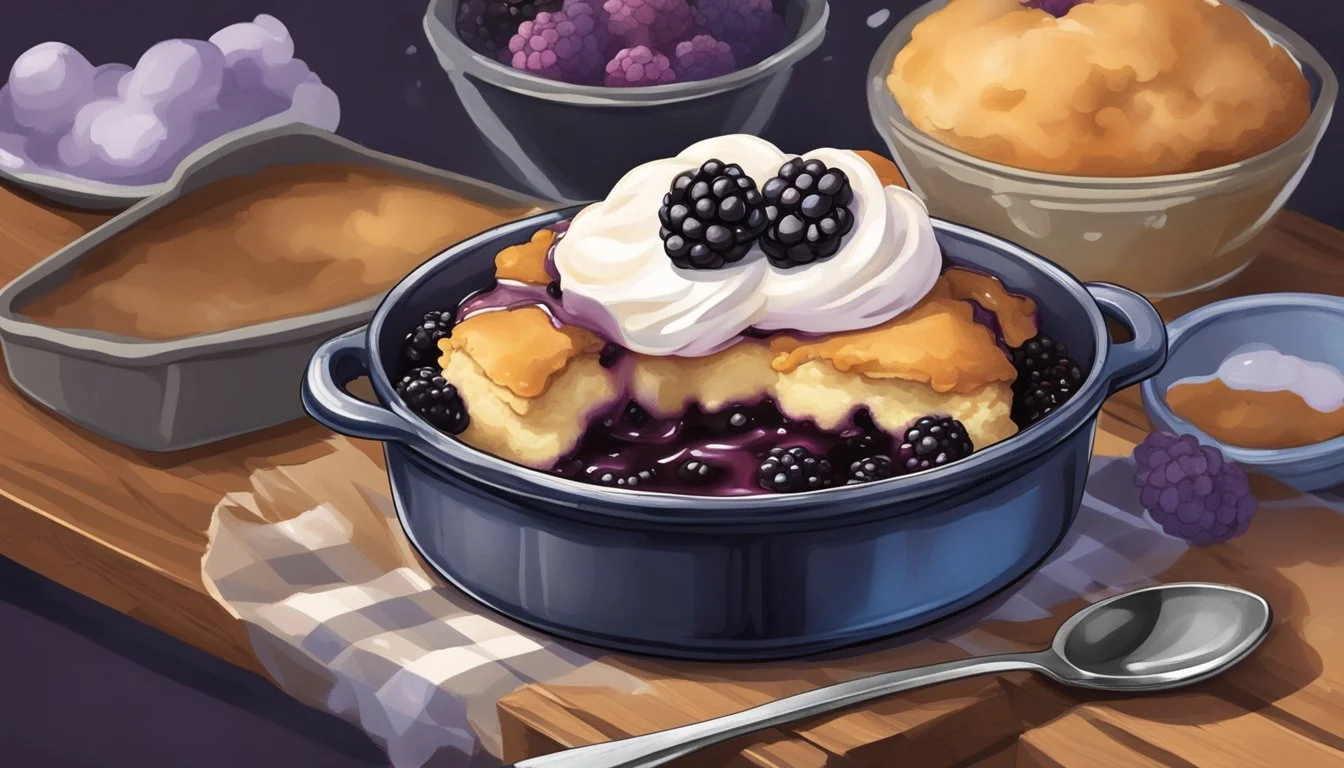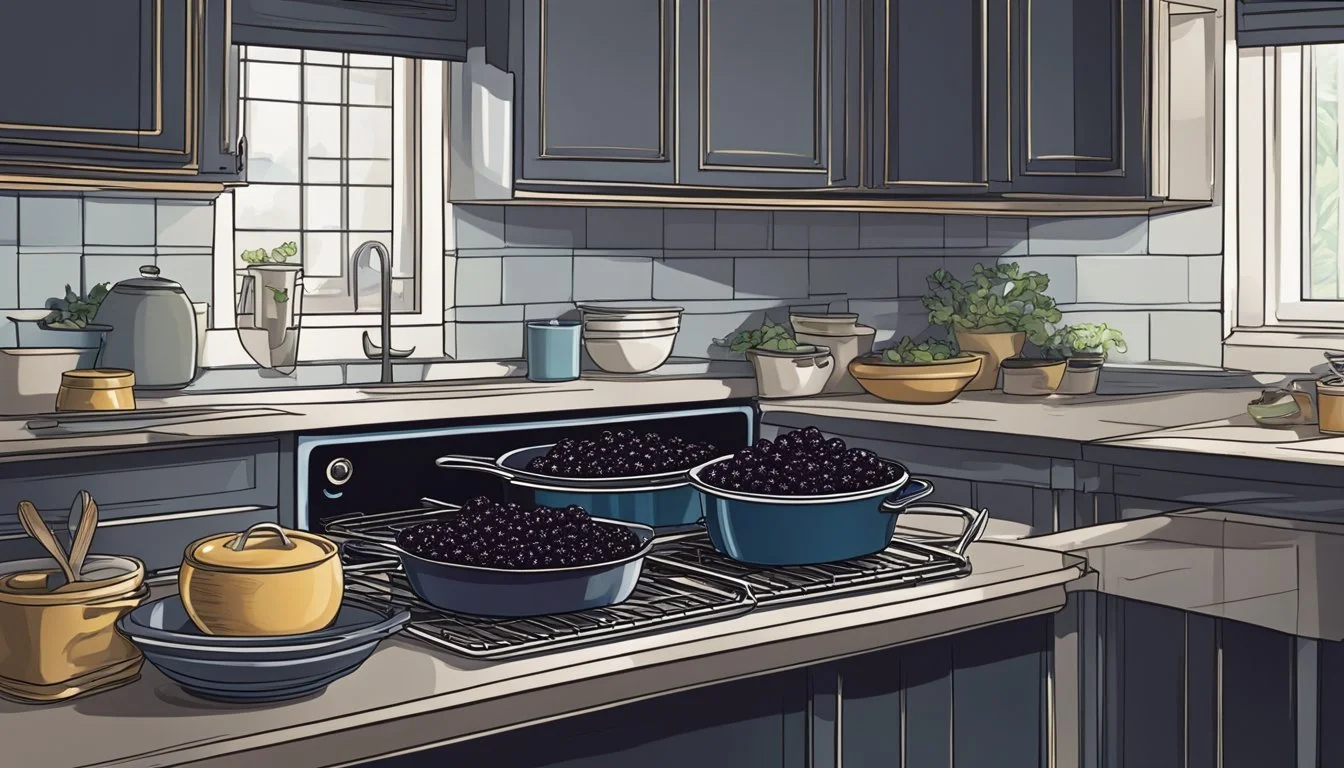How to Reheat Blackberry Cobbler
Best Methods Explained
Blackberry cobbler stands out as a classic dessert that combines the sweet and tart flavors of fresh or frozen blackberries with a warm, golden crust. Often enjoyed as a summer treat, it's a simple and easy-to-make delight that evokes nostalgia for many. To reheat blackberry cobbler, preheat your oven to 350°F (175°C), transfer the cobbler to an oven-safe dish if necessary, and cover loosely with aluminum foil.
Place the cobbler on the middle rack and reheat individual servings for 10-15 minutes or an entire dish for 30-45 minutes, depending on its size. This method ensures the cobbler remains moist and the crust does not burn. By following these steps, you can enjoy the delicious flavors of your blackberry cobbler, warm and comforting, just like when it was freshly baked.
Understanding Blackberry Cobbler
Blackberry cobbler is a cherished dessert, known for its combination of sweet, juicy blackberries and a tender, buttery topping. It can be made using either fresh or frozen berries, making it a versatile option for any occasion.
Key Ingredients for Blackberry Cobbler
A well-made blackberry cobbler relies on a few essential ingredients. The primary component is blackberries, which can be fresh or frozen. Fresh blackberries are preferred in the summer for their peak flavor, but frozen ones are a convenient alternative year-round.
Sugar is critical for enhancing the sweetness of the berries and balancing their natural tartness. Typically, around a cup of sugar is mixed with the fruit.
Flour and baking powder form the foundation of the cobbler topping. The flour provides structure, while the baking powder ensures a light and fluffy texture.
Butter is melted and mixed into the batter, adding richness and moisture. Milk helps to bind the dry ingredients, resulting in a pourable, smooth batter.
Finally, vanilla extract contributes a subtle flavor, rounding out the dessert’s profile.
The Role of Texture and Flavor
The success of a blackberry cobbler lies in the interplay between texture and flavor. The biscuit-like topping should be golden-brown and slightly crisp with a tender interior. This texture contrasts beautifully with the juiciness of the fruit filling.
Texture is also influenced by how the ingredients are combined. Overmixing the batter can result in a tough topping, so it's important to mix just until the ingredients are incorporated.
Flavor balance is crucial. The natural tartness of blackberries is complemented by the sweetness of the sugar and the buttery richness of the topping. The touch of vanilla adds depth, while the fruit remains the star.
By understanding these key elements, anyone can create a delicious blackberry cobbler that’s sure to impress.
Preparation Before Reheating
Proper preparation before reheating blackberry cobbler ensures that the dessert retains its flavor and texture. This involves cooling and storing it correctly and efficiently thawing it if frozen.
Proper Cooling and Storage Techniques
It's essential to let the cobbler cool completely to room temperature before storing it. This step helps retain the cobbler's crust texture, preventing it from becoming soggy. Use an airtight container to store leftover cobbler, ensuring it remains fresh and flavorful.
For storage in the refrigerator, wrap the cobbler tightly with plastic wrap or foil if an airtight container is unavailable. This method is suitable for short-term storage, typically up to five days. For longer periods, freezing is recommended.
When freezing, first wrap the cooled cobbler tightly using plastic wrap followed by aluminum foil. This double-wrapping provides extra protection against freezer burn. Place it in a freezer-safe container or plastic bag if an additional layer of protection is desired. This method allows the blackberry cobbler to be stored for up to three months without compromising quality.
Thawing Frozen Cobbler Efficiently
To maintain the cobbler's original texture, it's important to thaw the dessert in the refrigerator. Remove the cobbler from the freezer and leave it in the refrigerator overnight. This slow thawing method prevents excess moisture buildup, which can affect the crust's crispiness.
For a quicker thawing procedure, leave the frozen cobbler on the counter for 2-3 hours. Once thawed, let it reach room temperature before reheating. If time is of the essence, a microwave can be used in short intervals (15-30 seconds) to thaw individual servings.
When using the microwave method, avoid overheating, as this can make the cobbler mushy. Instead, proceed with caution, checking frequently to maintain the cobbler’s appealing texture.
Reheating Blackberry Cobbler in the Oven
Reheating blackberry cobbler in the oven ensures it retains its texture and flavor. Follow precise steps and avoid overheating for the best results.
Step-by-Step Oven Reheating Instructions
Preheat the Oven: Set the oven to 350°F (175°C).
Prepare the Dish: Transfer the cobbler from the fridge or freezer to an oven-safe dish, if it’s not already in one.
Cover: Loosely cover the dish with aluminum foil. This prevents the crust from burning while allowing even heating.
Reheat Time: For individual servings, heat for 10-15 minutes. For a whole cobbler, reheat for 30-45 minutes, depending on its size.
Check Readiness: Look for a golden brown crust and bubbly filling around the edges. If needed, reheat in additional 5-minute increments.
Optimizing Texture and Flavor Retention
To achieve the best texture and flavor, keep a few tips in mind:
Avoid Overheating: Too much heat can dry out the cobbler. Check the dish periodically to ensure it isn't overheating.
Use a Middle Rack: Placing the cobbler on the middle rack promotes even cooking, leading to a consistently warm and moist cobbler.
Add Moisture if Necessary: If the cobbler seems dry, lightly brush the top with melted butter or a fruit syrup before reheating.
Allowing Rest: Let the cobbler sit for a few minutes after reheating. This helps the filling settle and enhances flavors.
Using the Microwave for a Quick Reheat
Reheating blackberry cobbler in the microwave is ideal for a fast and convenient solution. It is essential, however, to follow the right steps to achieve a warm and enjoyable dessert while avoiding common pitfalls such as sogginess.
Microwave Reheating Method
To reheat blackberry cobbler in the microwave, first arrange a single serving on a microwave-safe plate. Cover the cobbler with a microwave-safe lid or a slightly damp paper towel. This technique helps retain moisture and prevent the topping from drying out.
Heat the cobbler at medium power in 20-second intervals, checking it after each interval. The total reheating time typically ranges from 1 to 2 minutes, depending on the microwave's wattage and the initial temperature of the cobbler. Heating in short bursts ensures even heating and prevents overheating, leading to a consistent and pleasant serving.
Preventing Sogginess in the Microwave
One main challenge when reheating cobbler in the microwave is avoiding a soggy consistency. To address this, sprinkle a few drops of water on the dessert before covering it with the damp paper towel. This small step can significantly improve the texture.
Another trick involves adjusting the power setting of the microwave to medium or half power (50%). Heating the cobbler slowly helps in maintaining its crispiness while warming the inside. Additionally, if the cobbler's crust softens too much, a brief session under the grill or broiler can help crisp it up again.
Strategically managing moisture and heat ensures the cobbler remains delicious and closer to its freshly baked state.
Serving Suggestions and Pairings
Blackberry cobbler can be enjoyed in many ways, and pairing it with certain ingredients can enhance its fruity flavor. Here are some ideas for ideal accompaniments and creative serving methods.
Ideal Accompaniments for Blackberry Cobbler
Vanilla Ice Cream: A scoop of vanilla ice cream is a classic pairing with blackberry cobbler. The creamy texture and sweet taste complement the tartness of the blackberries.
Whipped Cream: Freshly whipped cream adds a light, airy contrast to the dense cobbler. Consider adding a hint of vanilla or a sprinkle of cinnamon to the cream for extra flavor.
Custard or Cream Anglaise: If you prefer a richer option, custard or cream anglaise can be served alongside or drizzled over the cobbler. The smooth and creamy texture pairs well with the cobbler’s fruity filling.
Fresh Berries: Enhance the dish with a handful of fresh blackberries, raspberries, or blueberries. This addition underscores the cobbler’s natural fruity notes.
Nuts: Toasted almonds, pecans, or walnuts provide a satisfying crunch and add complexity to the dessert. Sprinkle them over the top just before serving.
Creative Serving Ideas
Parfait: Layer crumbled blackberry cobbler with vanilla yogurt or ice cream in a glass to create a visually appealing parfait. This presentation makes for a delightful dessert experience.
Cobbler Shake: Blend pieces of blackberry cobbler with vanilla ice cream and milk to create a decadent cobbler shake. This twist on the traditional milkshake is perfect for hot summer days.
Cobbler Trifle: Break the cobbler into chunks and layer it with custard and whipped cream in a trifle dish. This elegant dessert is great for entertaining guests.
Grilled Cobbler: For a unique spin, grill the cobbler briefly to give the crust a smoky flavor. Serve warm with a scoop of ice cream or a dollop of whipped cream.
Breakfast Cobbler: Serve leftover cobbler for breakfast with a dollop of Greek yogurt and a drizzle of honey. This option blends indulgence with a hint of healthiness, making it a versatile meal.
Incorporating these simple ingredients and creative ideas can elevate the experience of enjoying blackberry cobbler.
Nutritional Information
Blackberry cobbler is a delicious dessert, and understanding its nutritional content can help in making informed dietary choices.
A typical serving size of blackberry cobbler (about 1 cup) contains approximately:
Calories: 250-350 kcal
Protein: 3-5 grams
Fat: 10-15 grams
Carbohydrates: 40-50 grams
Fiber: 4-6 grams
The cobbler also provides various vitamins and minerals:
Iron: 10-15% of the Daily Value (DV)
Vitamin A: 5-10% of the DV
Vitamin C: 15-20% of the DV
Calcium: 6-8% of the DV
Key Ingredients:
Blackberries: Offer fiber, vitamin C, and antioxidants.
Flour and Sugar: Contribute to the carbohydrate content.
Butter: Adds fat and some calcium.
This dessert can be enjoyed in moderation as part of a balanced diet.
Recipe Enhancements and Variations
Enhancing a blackberry cobbler recipe can be a delightful way to cater to different tastes and preferences. Adjustments such as using alternative fruits or substituting sweeteners and flours can personalize the dish while maintaining its delicious nature.
Alternative Fruit Options
For those wanting to explore beyond blackberries, several fruit alternatives can be used. Peaches create a luscious peach cobbler that is both juicy and flavorful. Blueberries offer a balance of sweet and tart, and using them transforms the dish into a blueberry cobbler. Cherries bring a rich, deep flavor to a cherry cobbler, making it a delightful choice. Additionally, a mixed berry approach, combining blackberries with raspberries and strawberries, provides a colorful and flavorful variation. These alternatives can be used in the same quantity as blackberries, ensuring a straightforward swap without compromising the recipe’s results.
Substituting Sweeteners and Flours
Substitutions in sweeteners and flours can make the cobbler suitable for various dietary needs. Using honey or maple syrup instead of granulated sugar can offer a more natural sweetness. Coconut sugar is another alternative that provides a mild, caramel-like flavor.
For those who are gluten-intolerant, almond flour or oat flour can replace traditional self-rising flour. These alternatives maintain the cobbler’s texture while catering to specific dietary preferences. A combination of gluten-free all-purpose flour and a rising agent, such as baking powder, will also achieve similar results. Each substitution allows the cobbler to remain delicious while meeting individualized health and dietary needs.
Advanced Tips and Techniques
To achieve optimal results when reheating blackberry cobbler, consider these advanced techniques. These methods help maintain the cobbler's delicious flavors and textures while adding an extra touch of culinary excellence.
Achieving the Perfect Consistency
Reheating blackberry cobbler to the perfect consistency involves careful control of moisture and temperature. Place the cobbler on a baking sheet to facilitate even heat distribution. Preheat the oven to 300°F (150°C), this lower temperature prevents the cobbler from drying out.
Cover with aluminum foil to lock in moisture while allowing the crust to achieve a golden brown finish. Add a touch of lemon juice to the reheated cobbler for a fresh, tangy twist that complements the sweetness of the blackberries. Evenly sprinkle a hint of cinnamon before reheating for a warm, aromatic experience.
Pre-baking for the Ultimate Crunch
Achieving the ultimate crunch involves a few key steps. Pre-bake the cobbler crust separately before combining it with the filling. This technique ensures the crust remains crispy even after reheating. When prepping the cobbler originally, half-bake the crust and store it separately if planning for a make-ahead scenario.
To reheat, first bake the crust alone at 350°F (175°C) until it turns golden brown. Then, warm the filling separately to prevent overcooking the berries. After the crust and filling are heated, combine them and finish off in the oven for about 5 minutes. This method results in a perfect balance of crisp crust and moist, flavorful filling.
Long-Term Storage and Preservation
To keep blackberry cobbler fresh and delicious, proper storage methods are essential. Whether you choose freezing for longer preservation or refrigerating for short-term enjoyment, the following guidelines will help maintain its flavor and texture.
Freezing Techniques for Blackberry Cobbler
When freezing blackberry cobbler, start by allowing it to cool completely. Immediate freezing could lead to ice crystals forming on the cobbler, which might affect its texture. Once cooled, wrap the cobbler tightly in plastic wrap or aluminum foil to prevent freezer burn.
Next, place the wrapped cobbler in a sturdy freezer-safe container. This adds an extra layer of protection against moisture and helps maintain the cobbler’s structure.
Label the container with the date of freezing. Frozen cobbler can be stored for up to 2-3 months. When you’re ready to enjoy it, thaw overnight in the refrigerator and reheat in the oven (at 350°F for 15-20 minutes) to restore its original taste and texture.
Refrigerating for Short-Term Enjoyment
For short-term storage, the refrigerator is your best option. Once the cobbler has cooled to room temperature, cover it with plastic wrap or transfer it to an airtight container. This keeps out any unwanted odors and prevents it from drying out.
Refrigerated blackberry cobbler should be consumed within 3-4 days. When reheating, uncover the cobbler and place it in a preheated oven at 350°F. Reheat individual servings for 10-15 minutes and larger portions for a little longer to ensure even warming.
Keeping the cobbler properly stored in the refrigerator allows you to enjoy a tasty dessert over several days without compromising on its flavor or quality.



